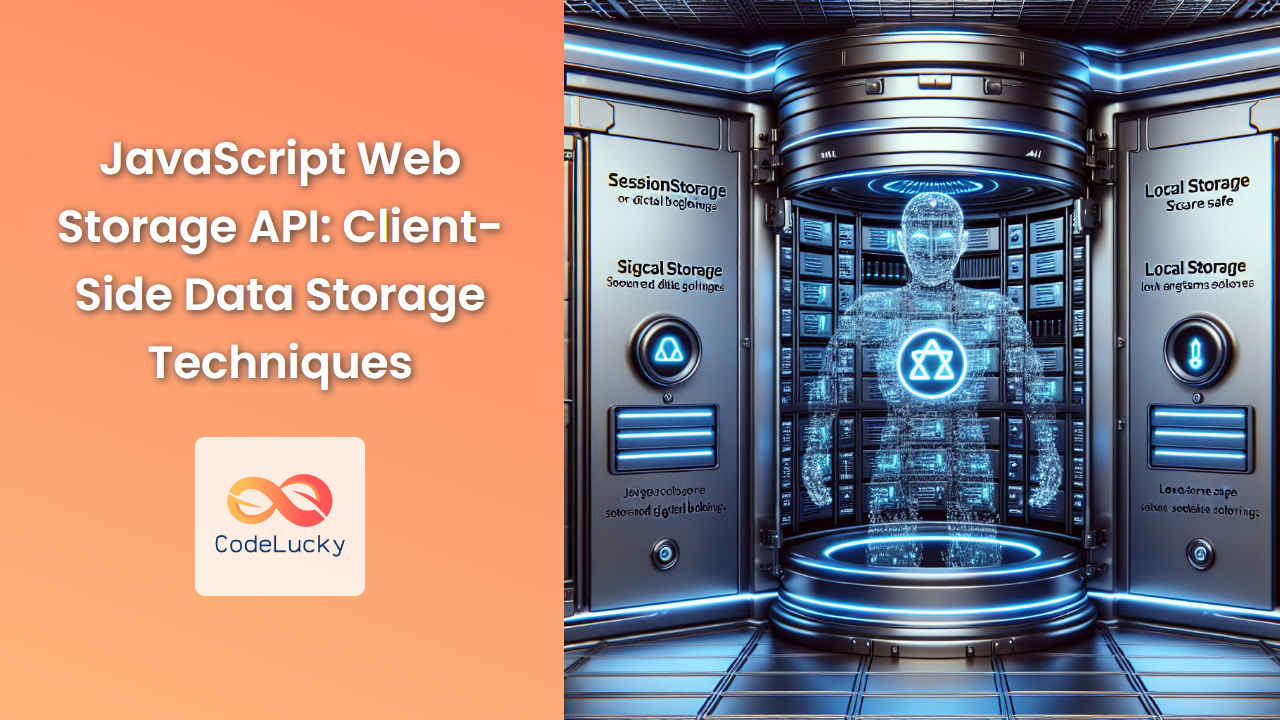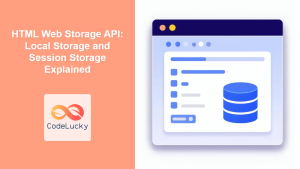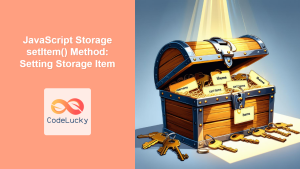In the ever-evolving landscape of web development, efficient data management is crucial for creating responsive and user-friendly applications. The JavaScript Web Storage API provides powerful tools for storing data on the client-side, offering developers the ability to enhance performance, reduce server load, and improve user experience. In this comprehensive guide, we'll dive deep into the world of client-side data storage techniques using the Web Storage API.
Understanding the Web Storage API
The Web Storage API is a set of mechanisms that allows web applications to store key-value pairs locally within the user's browser. It provides two main objects for storing data:
localStorage: Stores data with no expiration datesessionStorage: Stores data for one session (data is lost when the browser tab is closed)
Both of these objects provide a simple, yet powerful way to store and retrieve data on the client-side.
localStorage: Persistent Data Storage
localStorage is perfect for storing data that needs to persist across browser sessions. Let's explore how to use it effectively.
Storing Data in localStorage
To store data in localStorage, we use the setItem() method:
localStorage.setItem('username', 'JohnDoe');
localStorage.setItem('theme', 'dark');
localStorage.setItem('lastLogin', Date.now());
In this example, we're storing a username, theme preference, and the timestamp of the last login.
Retrieving Data from localStorage
To retrieve data from localStorage, we use the getItem() method:
const username = localStorage.getItem('username');
const theme = localStorage.getItem('theme');
const lastLogin = localStorage.getItem('lastLogin');
console.log(`Welcome back, ${username}!`);
console.log(`Your preferred theme is: ${theme}`);
console.log(`Last login: ${new Date(parseInt(lastLogin))}`);
This code retrieves the stored values and logs them to the console. Note that all values in localStorage are stored as strings, so we need to parse the lastLogin timestamp back to a number before creating a Date object.
Removing Data from localStorage
To remove a specific item from localStorage, use the removeItem() method:
localStorage.removeItem('theme');
To clear all data from localStorage, use the clear() method:
localStorage.clear();
🚀 Pro Tip: Be cautious when using clear() as it will remove all localStorage data for your domain, which might affect other parts of your application or other applications on the same domain.
Storing Complex Data Structures
localStorage can only store strings, but we can use JSON to store more complex data structures:
const user = {
name: 'Jane Doe',
age: 30,
preferences: {
newsletter: true,
darkMode: false
}
};
localStorage.setItem('user', JSON.stringify(user));
// Later, to retrieve and use the data:
const storedUser = JSON.parse(localStorage.getItem('user'));
console.log(`${storedUser.name} is ${storedUser.age} years old.`);
This technique allows us to store and retrieve complex objects easily.
sessionStorage: Temporary Session Data
sessionStorage works similarly to localStorage, but the data only persists for the duration of the browser session. It's ideal for storing temporary data that shouldn't persist across sessions.
Using sessionStorage
The methods for sessionStorage are identical to localStorage:
// Storing data
sessionStorage.setItem('cartItems', '5');
// Retrieving data
const cartItems = sessionStorage.getItem('cartItems');
console.log(`Items in cart: ${cartItems}`);
// Removing data
sessionStorage.removeItem('cartItems');
// Clearing all sessionStorage data
sessionStorage.clear();
🔑 Key Difference: Data in sessionStorage is cleared when the page session ends (i.e., when the tab is closed), while localStorage data persists until explicitly cleared.
Practical Examples and Use Cases
Let's explore some practical examples of how to use Web Storage in real-world scenarios.
Example 1: Remembering User Preferences
Suppose we have a website with a theme toggle. We can use localStorage to remember the user's preference:
const themeToggle = document.getElementById('theme-toggle');
const body = document.body;
// Check if a theme preference is stored
const storedTheme = localStorage.getItem('theme');
if (storedTheme) {
body.classList.add(storedTheme);
themeToggle.checked = storedTheme === 'dark-theme';
}
themeToggle.addEventListener('change', function() {
if (this.checked) {
body.classList.remove('light-theme');
body.classList.add('dark-theme');
localStorage.setItem('theme', 'dark-theme');
} else {
body.classList.remove('dark-theme');
body.classList.add('light-theme');
localStorage.setItem('theme', 'light-theme');
}
});
This code checks for a stored theme preference when the page loads and applies it. It also updates the stored preference when the user toggles the theme.
Example 2: Implementing a Shopping Cart
We can use sessionStorage to implement a simple shopping cart that persists across page reloads but clears when the browser is closed:
function addToCart(productId, productName, price) {
let cart = JSON.parse(sessionStorage.getItem('cart')) || [];
cart.push({ id: productId, name: productName, price: price });
sessionStorage.setItem('cart', JSON.stringify(cart));
updateCartDisplay();
}
function removeFromCart(productId) {
let cart = JSON.parse(sessionStorage.getItem('cart')) || [];
cart = cart.filter(item => item.id !== productId);
sessionStorage.setItem('cart', JSON.stringify(cart));
updateCartDisplay();
}
function updateCartDisplay() {
const cartElement = document.getElementById('cart');
const cart = JSON.parse(sessionStorage.getItem('cart')) || [];
if (cart.length === 0) {
cartElement.innerHTML = '<p>Your cart is empty</p>';
return;
}
let cartHTML = '<ul>';
let total = 0;
cart.forEach(item => {
cartHTML += `<li>${item.name} - $${item.price} <button onclick="removeFromCart(${item.id})">Remove</button></li>`;
total += item.price;
});
cartHTML += '</ul>';
cartHTML += `<p>Total: $${total.toFixed(2)}</p>`;
cartElement.innerHTML = cartHTML;
}
// Call this when the page loads
updateCartDisplay();
This example demonstrates how to use sessionStorage to maintain a shopping cart across different pages of an e-commerce site.
Example 3: Caching API Responses
We can use localStorage to cache API responses and reduce unnecessary network requests:
async function fetchUserData(userId) {
const cachedData = localStorage.getItem(`user_${userId}`);
if (cachedData) {
const { data, timestamp } = JSON.parse(cachedData);
// Check if the cache is less than 5 minutes old
if (Date.now() - timestamp < 5 * 60 * 1000) {
console.log('Returning cached data');
return data;
}
}
// If no cache or cache is old, fetch new data
console.log('Fetching fresh data');
const response = await fetch(`https://api.example.com/users/${userId}`);
const data = await response.json();
// Cache the new data
localStorage.setItem(`user_${userId}`, JSON.stringify({
data: data,
timestamp: Date.now()
}));
return data;
}
// Usage
fetchUserData(123).then(userData => {
console.log(userData);
});
This function checks for cached user data before making an API request. If the cached data is less than 5 minutes old, it returns the cached data. Otherwise, it fetches fresh data and updates the cache.
Best Practices and Considerations
When working with Web Storage, keep these best practices in mind:
-
🔒 Security: Never store sensitive information like passwords or credit card details in Web Storage, as it's not secure.
-
📊 Size Limits: Both localStorage and sessionStorage have size limits (usually around 5-10MB). Be mindful of how much data you're storing.
-
🔄 Performance: Accessing Web Storage is synchronous and can block the main thread. For large amounts of data, consider using IndexedDB instead.
-
🌐 Same-Origin Policy: Web Storage is subject to the same-origin policy. Data stored by one origin cannot be accessed by another origin.
-
🧹 Data Cleanup: Implement mechanisms to clean up old or unnecessary data to prevent storage from filling up.
-
🔢 Version Control: When storing structured data, consider including a version number to handle schema changes in your application.
Browser Support and Fallbacks
The Web Storage API is widely supported in modern browsers. However, it's always a good practice to check for support before using it:
function storageAvailable(type) {
let storage;
try {
storage = window[type];
const x = '__storage_test__';
storage.setItem(x, x);
storage.removeItem(x);
return true;
}
catch(e) {
return e instanceof DOMException && (
// everything except Firefox
e.code === 22 ||
// Firefox
e.code === 1014 ||
// test name field too, because code might not be present
// everything except Firefox
e.name === 'QuotaExceededError' ||
// Firefox
e.name === 'NS_ERROR_DOM_QUOTA_REACHED') &&
// acknowledge QuotaExceededError only if there's something already stored
(storage && storage.length !== 0);
}
}
if (storageAvailable('localStorage')) {
// localStorage is available
} else {
// Fall back to cookies or in-memory storage
}
This function checks if localStorage (or sessionStorage) is available and working correctly.
Conclusion
The Web Storage API provides powerful tools for client-side data storage in web applications. By leveraging localStorage and sessionStorage, developers can create more responsive, efficient, and user-friendly web experiences. From remembering user preferences to implementing shopping carts and caching API responses, the possibilities are vast.
As you incorporate these techniques into your projects, remember to consider security implications, respect storage limits, and implement proper data management practices. With careful implementation, Web Storage can significantly enhance the performance and functionality of your web applications.
By mastering these client-side data storage techniques, you're well on your way to creating more sophisticated and responsive web applications that provide excellent user experiences while reducing server load. Happy coding! 🚀👨💻👩💻



















